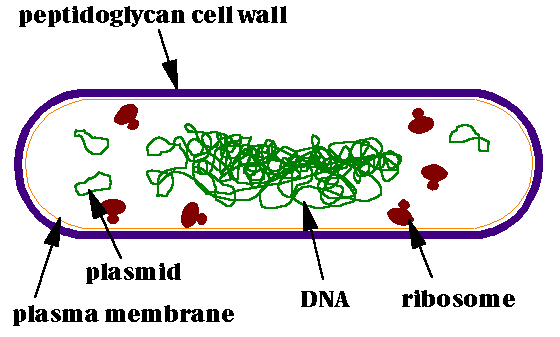



Bacteria: More on Morphology






A more or less typical bacterium, shown here, is comparatively much simpler than a typical eukaryotic cell. View the transmission electron micrograph of a typical bacterium, E. coli, below and compare it with the diagram above.
Bacteria lack the membrane-bound nuclei of eukaryotes; their DNA forms a tangle known as a nucleoid, but there is no membrane around the nucleoid, and the DNA is not bound to proteins as it is in eukaryotes. Whereas eukaryote DNA is organized into linear pieces, the chromosomes, bacterial DNA forms loops. Bacteria contain plasmids, or small loops of DNA, that can be transmitted from one cell to another, either in the course of sex (yes, bacteria have sex) or by viruses. This ability to trade genes with all comers makes bacteria amazingly adaptible; beneficial genes, like those for antibiotic resistance, may be spread very rapidly through bacterial populations. It also makes bacteria favorites of molecular biologists and genetic engineers; new genes can be inserted into bacteria with ease.
Bacteria do not contain membrane-bound organelles such as mitochondria or chloroplasts, as eukaryotes do. However, photosynthetic bacteria, such as cyanobacteria, may be filled with tightly packed folds of their outer membrane. The effect of these membranes is to increase the potential surface area on which photosynthesis can take place.
The cell membrane is surrounded by a cell wall in all bacteria except one group, the Mollicutes, which includes pathogens such as the mycoplasmas. The composition of the cell wall varies among species and is an important character for identifying and classifying bacteria. In this diagram, the bacterium has a fairly thick cell wall made of peptidoglycan (carbohydrate polymers cross-linked by proteins); such bacteria retain a purple color when stained with a dye known as crystal violet, and are known as Gram-positive (after the Danish bacteriologist who developed this staining procedure). Other bacteria have double cell walls, with a thin inner wall of peptidoglycan and an outer wall of carbohydrates, proteins, and lipids. Such bacteria do not stain purple with crystal violet and are known as Gram-negative.


